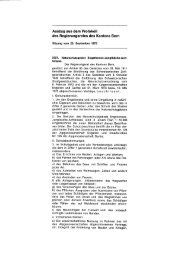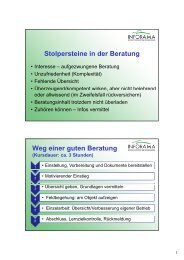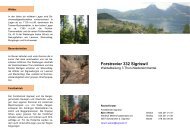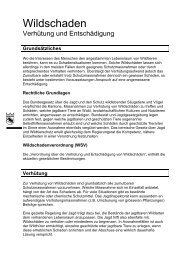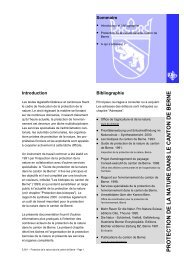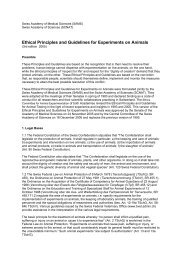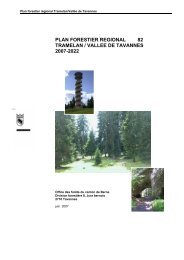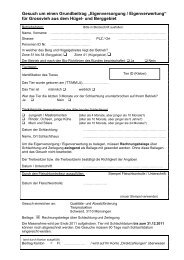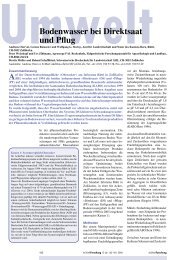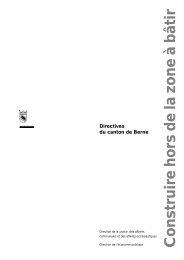Vergleichsökobilanz bei Direktsaat und Pflug
Vergleichsökobilanz bei Direktsaat und Pflug
Vergleichsökobilanz bei Direktsaat und Pflug
Erfolgreiche ePaper selbst erstellen
Machen Sie aus Ihren PDF Publikationen ein blätterbares Flipbook mit unserer einzigartigen Google optimierten e-Paper Software.
weise Phosphorabschwemmung<strong>bei</strong> Hanglagen.Grösser als der Einfluss der Bodenbear<strong>bei</strong>tung,insbesondereauf die Umweltwirkungen desRessourcenmanagements, istallerdings der Einfluss der Mineraldüngung.Erfolgt die Beurteilungflächenbezogen, werdendie nicht oder wenig gedüngtenKulturen wie Eiweisserbsen <strong>und</strong>Winterroggen günstiger bewertetals die stärker gedüngten.Bei der ertragsbezogenen Betrachtungsweisewerden hingegendie ertragsstarken Kulturenwie Zuckerrüben <strong>und</strong> Silomaisam günstigsten beurteilt.Die Umweltwirkungen desSchadstoffmanagements werdenam entscheidendsten durch diegewählten Wirkstoffe der Pflanzenschutzmittel(selektive Herbizide)beziehungsweise derenWirkungsbeurteilung je nach angewendeterMethodik geprägt.LiteraturChervet A., Maurer C., SturnyW. G. & Müller M., 2001. <strong>Direktsaat</strong>im Praxisversuch; Einflussauf die Struktur des Bodens. Agrarforschung8 (1), 12-17.Chervet A., Ramseier L., SturnyW. G. & Tschannen S., 2005. <strong>Direktsaat</strong><strong>und</strong> <strong>Pflug</strong> im 10-jährigenSystemvergleich. Agrarforschung12 (5), 184-189.Eidg. Forschungsanstalt fürAgrarökologie <strong>und</strong> LandbauReckenholz (FAL) & Eidg. Forschungsanstaltfür PflanzenbauChangins (RAC), 2001. Gr<strong>und</strong>lagenfür die Düngung im Acker<strong>und</strong>Futterbau 2001. Agrarforschung8 (6), 80 S.Gaillard G., Freiermuth R.,Baumgartner D., Calanca P. L.,Jeanneret P., Nemecek T., OberholzerH. R., Prasuhn V., RichnerW. & Weisskopf P., 2006. Methodezur Ökobilanzierung landwirtschaftlicherSysteme. Schriftenreiheder ART. In Vorbereitung.ISO, 1997. ISO 14040 – Umweltmanagement/Ökobilanz,14 S.Nemecek T., Huguenin-Elie O.,Dubois D. & Gaillard G., 2005.Ökobilanzierung von Anbausystemenim Schweizerischen Acker<strong>und</strong>Futterbau. Schriftenreihe derFAL 58, 155 S.Oberholzer H.-R., Weisskopf P.,Gaillard G., Weiss F. & FreiermuthR., 2006. Methode zur Beurteilungder Wirkungen landwirtschaftlicherBewirtschaftung auf die Bodenqualitätin Ökobilanzen - SALCA-BQ.Bericht Agroscope Reckenholz-TänikonART, 69S.Prasuhn V. & Grünig K., 2001.Evaluation der Ökomassnahmen.Phosphorbelastung der Oberflächengewässerdurch Bodenerosion.Schriftenreihe der FAL 37, 152 S.Schweizerische Eidgenossenschaft,1983. B<strong>und</strong>esgesetz vom7. Oktober 1983 über den Umweltschutz(Umweltschutzgesetz,USG). Systematische Sammlungdes B<strong>und</strong>esrechts, SR-Nr. 814.01RésuméBilan écologique comparatif du semis direct et du labourLes systèmes de culture avec labour (LA) ou en semis direct(SD) sont comparés depuis 1994 sur un sol mi-lourd de l’InforamaRütti, Zollikofen (BE), dans le cadre d’une rotation degrandes cultures sans périodes de jachère. Les effets des deuxsystèmes sur l’environnement ont été calculés sous la forme d’unbilan écologique pour la période de culture 1999 à 2005.Les calculs ont pris en compte la gestion des ressources, des nutrimentset des pollutions. Le système SD, qui évite tout travaildu sol, peut être considéré comme favorable par rapport au systèmeLA, dans lequel un travail du sol intervient régulièrement.Ceci vaut que la comparaison soit faite par rapport à la surfaceagricole ou par rapport aux rendements en matière sèche. Un effetpositif a aussi été obtenu quant à la qualité du sol. Il s’agit desuivre les effets un peu accrus du besoin en herbicides dans lesystème SD; les effets polluants des deux systèmes sont toutefoistrès dépendants du choix des matières actives.Les risques d’érosion et d’entraînement du P ont été estimés àl’aide d’un modèle de calcul prenant en compte l’inclinaisondu terrain. Jusqu’à une pente de 18 %, les risques sont toujoursfaibles dans le système SD, mais l’entraînement augmente fortementavec la pente dans le système LA.SummaryLife cycle assessment of a system <strong>und</strong>er no-tillage andploughingNo-tillage and conventional plough tillage have been compared ona soil of medium heavy texture in a crop rotation without fallowperiod at the Inforama Ruetti in Zollikofen (Berne) since 1994.For the crop rotation period from 1999 to 2005 the environmentalimpact of both systems was calculated via life cycle assessment.With regard to resources, nutrients and pollutant management,the environmental impact of the no-tillage system is more favourablethan the conventional system involving periodical tillageoperations, both per hectare of arable land and annum, andper kilogram of harvested dry matter. For the no-tillage systempositive changes were also fo<strong>und</strong> in the assessment of soil quality.It is essential to follow up the impacts of the slightly higherherbicide requirement characterizing the no-tillage system. Inboth systems, however, pollutant management is strongly influencedby the choice of the active ingredient applied.According to model calculations in which slope gradient wasvaried, the risk of soil erosion and P-runoff remained constantlylow up to a gradient of 18 % in the no-tillage system. In contrast,the risk of runoff increased steeply with increasing slope gradientin the conventional tillage system.Key words: Life cycle assessment, energy demand, ecotoxicity,tillage system, no-tillage487AGRARForschung



